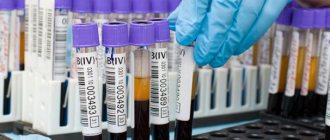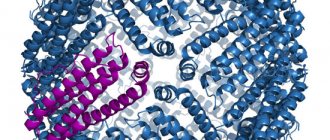Glycated hemoglobin level is an indicator that reflects the average concentration of glucose in the patient’s blood over 3 months. Glycating hemoglobin is a chemical compound of hemoglobin (a protein found in red blood cells that performs the function of delivering oxygen to cells and tissues) with glucose.
Measuring glycated hemoglobin in a patient will show both compliance with the attending physician’s recommendations regarding diet (direct testing at an appointment may result in distorted results - for example, the person did not have breakfast on purpose), and the dynamics of the patient’s condition.
Normal for women and men
The norm of glycated hemoglobin in men and women is the same and does not depend on gender. Glycated hemoglobin also does not differ by age: there are certain percentage limits for the content of this type of hemoglobin in the blood relative to the entire hemoglobin fraction.
An acceptable indicator is considered to be 4.27-6.07%. This is the norm for glycated hemoglobin, and if the patient’s value is in the specified range, it means that the person is healthy and cannot be diagnosed with diabetes mellitus.
The research results can be clearly presented in the table of glycated hemoglobin, which indicates the levels of the indicator and the patient’s condition.
Table 1. Results of the study on the level of glycated hemoglobin
| Laboratory value of the indicator | Research result |
| 4-6,2% | The patient is absolutely healthy, the glucose level is normal. The person is not at risk of developing diabetes mellitus |
| 5,7-6,4% | The patient is in a state of prediabetes (in this case, the tolerance of cell receptors to glucose is impaired, and there is a high risk of developing diabetes) |
| 6.5% or more | The patient has diabetes and requires drug intervention |
The norm of glycated hemoglobin in women does not differ from the normal level in men.
You should carefully monitor the level of glycated hemoglobin: the higher the percentage value, the faster the risk of developing diabetes complications increases!
Who's at risk
Risk factors for gestational diabetes
| Risk factor | Consequences |
| Mother's age is over 40 years old | Large fruit |
| Maternal obesity, or excess body weight | Polyhydramnios |
| History of gestational diabetes | Excessive weight gain during current pregnancy |
| History of early or late gestosis | Congenital malformations of the fetus |
| Diabetes mellitus in close relatives | Excretion of glucose in urine |
| History of miscarriage or stillbirth | |
| Diseases and conditions that can provoke the development of diabetes (metabolic syndrome, polycystic ovary syndrome, high blood pressure, high cholesterol) | |
| Multiple pregnancy |
What does glycated hemoglobin show?
The doctor prescribes a study in order to assess the condition of the patient’s body:
- Timely and high-quality control of blood glucose levels in patients suffering from diabetes. For people with diabetes, it is very important to control a certain level of glucose in the blood: firstly, for good general health, and secondly, to prevent the formation of complications. A long period of increased glucose levels threatens complications in the form of dysfunction of the kidneys, eyes (development of diabetic retinopathy), cardiovascular and nervous system.
- Monitor the patient's blood glucose levels over the past 2-3 months. The uniqueness of the study lies in the fact that the doctor receives data not only at the time of visiting the patient, but also over time: the level of glycated hemoglobin will provide information about the concentration of blood glucose over a long period.
- Monitoring the dynamics of treatment. Thanks to the diagnosis, the doctor will assess the correctness and effectiveness of the treatment tactics, and, if necessary, adjust the dosages of the drugs.
- Preventive measure. Even healthy people are recommended to check glycated hemoglobin in order to promptly diagnose the development of diabetes at an early stage. Early diagnosis is known to more effectively and quickly suppress the progression of the disease.
What else does glycated hemoglobin show? Determining the norm of glycated hemoglobin helps to detect and track sudden increases in glucose levels in patients with diabetes mellitus, which has only recently been diagnosed. In this case, the doctor can order a test several times until he is sure that the patient’s blood glucose level has been established, and he can simply continue the therapy regimen.
You will then need to be tested several times a year to confirm normal blood glucose levels.
What is its reason?
Diabetes mellitus in pregnant women develops due to the hormonal explosion associated with bearing a child. The hormonal cocktail entering the blood (cortisol, human chorionic gonadotropin, estrogens and progesterone) inhibits the action of insulin, which is required to ensure the flow of glucose from the blood into the cells. This happens because the body tries to save glucose for the growing fetus and provokes “insulin resistance,” when the mother’s cells stop responding to the usual amount of insulin. In response to increasing amounts of glucose in the blood, the pancreas is supposed to produce more insulin, but sometimes it fails. Gestational diabetes occurs.
Up to 39% of all pregnancies are complicated by GDM.
How to get tested for glycated hemoglobin?
Blood is taken for research from a vein . Diagnostics does not require special preparation rules; you just need to follow some general recommendations. The patient, as before other tests, should not eat food 2-3 hours before blood sampling; he is only allowed to drink clean, still water. You should not smoke 30 minutes before the test, and you should also avoid physical and emotional stress.
Analysis for glycated hemoglobin - how to donate blood ? There are no specific features when collecting blood from a vein to study glycosylated hemoglobin. According to the standard algorithm for collecting blood from a vein, the patient enters the manipulation room and takes a comfortable position. At the same time, he places his hand on a special hard cushion, bending it slightly at the elbow joint. The nurse bandages the arm above the elbow with a special tourniquet.
The medical professional assesses the condition of the patient's veins, selects the most full vein, treats the area with alcohol, inserts a needle, and draws blood into a vacuum tube.
Then the nurse draws blood to a special mark and removes the needle. A cotton ball is applied to the puncture site.
There is also a scheme for collecting blood using a disposable syringe, however, in modern laboratories they use a system of vacuum tubes - in this case, the likelihood of contact of the patient’s blood with the surface of the skin of medical personnel is reduced, and the risk of damage to blood cells is also reduced.
Then the material is sent for diagnostics, and after some time the patient receives the results of the study, with which he is sent to the attending physician.
Are there any contraindications to the test?
Yes, I have. Absolute and relative.
Absolute contraindications include:
- Allergy and/or glucose intolerance,
- Diabetes mellitus in the acute phase (then a test is not needed),
- Diseases of the gastrointestinal tract in which normal glucose absorption is disrupted (exacerbation of pancreatitis, gastric surgery).
Relative (temporary) contraindications:
- Early toxicosis (gestosis) of pregnant women,
- Exacerbation of chronic diseases
Important! It is very important to determine the presence of GDM in a timely manner. Screening is recommended for all pregnant women. The glucose tolerance test does not harm the liver and is not something to be afraid of.
When diagnosing GDM, additional tests are sometimes used, including:
- General urine analysis (glucosuria - detection of glucose in the urine, which normally should not be there, as well as ketone bodies - products of impaired glucose metabolism),
- Ultrasound of the fetus (presence of fetopathy - fetal development disorders).
Features of the study
The level of glycated hemoglobin may increase under the following conditions:
- the risk of developing diabetes mellitus or the presence of this disease;
- lack of vitamin B12, as well as iron - both components are closely related to hemoglobin metabolism;
- active consumption of alcohol or alcoholic beverages, alcoholism;
- a pronounced decrease in the acidity of erythrocytes;
- chronic renal failure, renal dysfunction;
- genetic or biochemically caused disorders in the protein composition of the blood;
- increased life expectancy of red blood cells;
- against the background of active use of opiates.
The glycating hemoglobin level decreases in the following situations:
- against the background of active intake of vitamin preparations, especially vitamin C, B12;
- for chronic liver diseases;
- against the background of increased acidity of red blood cells;
- when using certain medications, such as aspirin or antiviral drugs;
- with reduced life expectancy of red blood cells.
Before prescribing a diagnosis, the patient must tell the attending physician about the medications that the person is taking, because some medications can have a significant impact on the test result.
Assessing the level of glycated hemoglobin is an important diagnostic criterion that helps the doctor suspect the development of diabetes mellitus in a patient, prescribe additional research methods in a timely manner and begin therapy.
The interpretation of diagnostic results should be carried out exclusively by the attending physician - only the doctor fully understands all the factors that could have influenced the study indicator.
Symptoms
Photo: ruslangaliullin / freepik.com
The clinical picture of gestational diabetes mellitus is quite poor; a woman may not have any complaints at all. It is worth paying attention to the following signs:
- Unmotivated weakness
- Thirst, dry mouth,
- Frequent urination
- Blurred vision.
Prevention
Photo: olezhkalina / freepik.com
The main measure to prevent GDM is weight control and careful planning of pregnancy.
Obesity is one of the main risk factors for the development of GDM. The more fat there is in the body, the less responsive its cells become to insulin's commands to capture glucose from the blood.
Important! Trying to lose weight during pregnancy is not worth it. You must eat enough so that the fetus does not suffer from lack of nutrients.
Treatment during pregnancy
Treatment of GDM is a complex and complex task. The drugs are selected so as not to harm the fetus. And treatment, if necessary, can continue after childbirth.
Diet
Following a special diet is the first step towards getting rid of gestational diabetes. Drug treatment for GDM will not be effective without diet. What you need to pay attention to:
- It is necessary to exclude fast carbohydrates (sweets, pastries, white bread, cakes, fruits), and also limit fats,
- There should be several meals, you should eat every 2-3 hours,
- You should consume enough protein and reduce your intake of foods high in starch (rice, bread, pasta, potatoes, corn),
- It will be useful to increase the consumption of vegetables and herbs, vegetable oils and other foods rich in unsaturated fats,
- It is important to maintain a balance of proteins, carbohydrates and fats, as well as monitor the caloric content of your diet.
Important! You can’t prescribe your own diet! It should be compiled by a specialist taking into account the needs of the expectant mother and baby.
In addition to dietary changes, incorporate moderate, regular physical activity into your daily routine. Exercise at least 150 minutes a week; swimming is very beneficial.
Blood Sugar Tracking
The second step in the fight against GDM is daily monitoring of blood sugar. It is needed to understand whether the diet helps.
To determine your glucose, you do not need to go to the doctor; for this there is a special device - a glucometer (Fig. 3).
Figure 3. A set of a glucometer, a skin-piercing pen, a set of test strips and needles for a cartridge pen. Source: WikiMedia
With its help, patients with GDM check their glucose levels on an empty stomach and 1-2 hours after meals every day for a week, recording the data in a journal. Based on the results obtained, the endocrinologist decides whether drug treatment is required, or whether GDM has already been controlled through dietary restrictions. Medicines are prescribed if one third or more of the results indicate glucose levels:
- on an empty stomach - more than 5.3 mmol/l,
- an hour after eating - more than 7.2-7.8 mmol/l,
- 2 hours after eating - more than 6.5 mmol/l.
Sometimes your doctor will also ask you to keep a diary of your blood pressure, body weight, and nutrition. You can also monitor sugar in your urine using test strips.
Important! Devices without a needle have already appeared - it is replaced by a sensor in the form of a patch that is glued to the skin. The glucometer reads its readings continuously. You can configure the device so that the data is sent to your mobile phone or immediately sent to the doctor.
Drug treatment: insulin
To control glycemic levels, hypoglycemic drugs are prescribed:
- In case of uncontrolled glycemia and the presence of fetopathy, insulin is used first. It is safe for the fetus; the dose and mode of administration are determined by the endocrinologist on an individual basis.
- In some cases, an insulin pump is installed for better glycemic control.
- Tablets of hypoglycemic drugs are used strictly according to indications.
During treatment, blood sugar control is not interrupted; all data on drug doses and blood glucose levels are recorded so that the doctor can adjust the dosage regimen.
Important! Insulin is considered the best treatment for GDM. To date, there is not enough data to judge the delayed effects of other glucose-lowering drugs.








